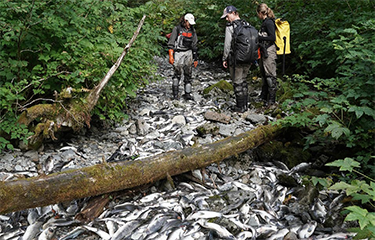A new paper published 15 February in Fisheries Magazine confirms that salmon spawns fared worse in hotter, drier conditions.
The new paper, "Premature Mortality Observations among Alaska’s Pacific Salmon During Record Heat and Drought in 2019," found salmon had higher spawning success in glacier and snow-fed streams than in rain-fed streams in hot, dry conditions.
Drought conditions in 2019 caused many rain-fed streams in Alaska to dry up. In some cases, spawning salmon milled about at the mouths of streams waiting for sufficient water for the ascent. In other cases, they entered at high tide, but were left stranded on the streambed when the tide receded, or congregated in pools where they suffered from heat stress and low dissolved oxygen levels.
Alaska's Prince William Sound had the most-documented mass mortalities. The report’s authors used information from aerial surveys routinely conducted by the Alaska Department of Fish and Game to determine the level of breeding success of pink salmon in various streams categorized according to whether they were fed by rain, snow, or glaciers. The greater reliability of flow and coolness of water in glacial streams reduced heat stress and strandings, so these provided the best spawning success in the hot, dry conditions, the study found.
The nearby Copper River, which does not flow into Prince William Sound, was an exception to the rule, as rapid glacial melting there caused flooding, impeding migration.
Since salmon die after spawning, “premature” mortality means they died before spawning. In 13 percent of cases, premature death was confirmed by examining the dead fish, but in most cases the determination was made based on location and time of year. For example, a carcass found along a migration route and well downstream of a spawning habitat was considered a premature mortality.
One of the report's authors, Peter Rand, a research ecologist with the Prince William Sound Science Center, said despite fewer successful spawnings, lower competition for food facing salmon while they were in the ocean actually seems to have led to good returns.
“During 2019, those were parents that produced young that returned this past year, in 2021," he said. "Pink salmon have a fixed two-year life-cycle – and they came back strong. Even though these fish were hit hard – especially the Prince William Sound fish – they were able to successfully spawn and produce young. It was favorable ocean conditions that year, so that benefitted them. Part of this is that they can be very adaptable.”
Rand said that pinks tend to stray more than other salmon species, and some may enter watersheds neighboring the one they originated from. Adaptive fishery management also helped, he said. Managers limited the harvest to increase returns during critical times.
“There was a period in late July and into August where it was very high air temperatures and very little rainfall. So, the managers fly the streams, count salmon, see where they are – and in that year they noticed that there was very little fresh water for them to enter, and they were milling around the bays. And so they reduced fishing pressure during that time, until the rain. We got rain in early September and that filled the streams. So they were able to adapt – to change the fishing intensity to allow more fish to pass through,” he said.
While this worked well to ensure adequate escapement in Prince William Sound, adaptive management is not the rule, Rand said.
“I think this is a good example of taking into account changes in river conditions in terms of setting quotas or managing fisheries,” he said. “It’s adaptive management – considering changes in the river and how that would translate into harvest rates. In the Copper and many other systems, it’s not part of the management. I think it’s a reliance on relatively stable environmental conditions, but that’s not the case anymore.”
In British Columbia, which has had warm water problems and mortality problems in the Fraser River sockeye run, managers have developed a management system that directly takes into account the temperature and flow conditions in the river.
“I think that’s what Alaska is going to have to adapt [to do] to account for these changes,” Rand said. “They need to be more conservative. These conditions are probably going to become more frequent in the future.”
Rand said next steps in researching the issue will include sampling salmon DNA to check for genes that are known to be expressed in response to specific stressors, such as thermal stress, exertion, and infection by certain pathogens.
Photo courtesy of Brad Von Wichman/Babkin Charters







